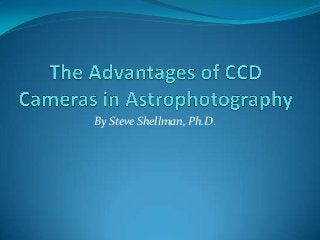
The advantages of ccd cameras in astrophotography by steve shellman, ph.d.
- 1. By Steve Shellman, Ph.D.
- 2. The Advantages of CCD Cameras in Astrophotography During the late 1990s, many amateur astronomers switched to powerful CCD (charged couple device) cameras, the same equipment used by observatories. CCD technology consists of a chip with an array of semiconductors that develop a charge when contacting light. CCD devices have the capacity to measure individual photons and discriminate between light frequencies. Consequently, with this advanced technology, astronomers and astrophotographers can view deep sky images in greater detail.
- 3. The Advantages of CCD Cameras in Astrophotography The CCD camera is designed for use with telescopes, and when placed on a mount, it replaces the eyepiece of a telescope. The camera connects to a computer that facilitates the capture and storage of images through specialized software. Astrophotographers can then export these images into photo editing applications to perfect the images.
- 4. The Advantages of CCD Cameras in Astrophotography The CCD camera offers many advantages for astrophotographers. Compared to digital SLR cameras, CCD cameras are many times more sensitive to light, and this lessens the necessary exposure time for capturing faint images. This sensitivity also means that using filters is easier. Additionally, these cameras take excellent wide angle shots. When taking long exposures of galaxies and nebulae, astrophotographers use a technique called guiding. To facilitate guiding, CCD cameras have built-in guiding chips to simplify the process. Furthermore, CCD chips produce images with fewer pixel defects. Finally, CCD cameras often feature thermoelectric cooling that reduces noise. Overall, the CCD camera is unsurpassed when it comes to amateur astrophotography, but it remains an expensive camera technology.
- 5. About the Author An amateur astronomer who resides in Williamsburg, Virginia, Stephen M. Shellman enjoys astrophotography and sharing astro images on his website, www.atticbluffsobservatory.com. By profession, he is a social scientist with a Ph.D. in Political Science who conducts research on the causes and consequences of international political conflict and terrorism.
